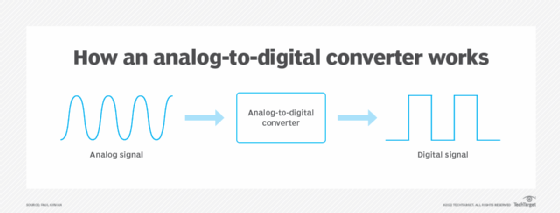digital video
What is a digital video?
Digital video is audio/visual content in a binary format, with information is presented as a sequence of digital data rather than in a continuous signal as analog information is.
Information in the natural world, received through the five senses, is analog. That means that it is infinitely variable. Digital A/V information, on the other hand, consists of discrete units of data that are placed so close together that the human senses perceive them as a continuous flow.
Analog data, such as video recorded on tape, is transmitted as electronic signals of varying frequency or amplitude that are added to carrier waves of a given frequency.
What is the history of digital video?
The first digital video recorder (DVR) was invented in 1977 by Ampex, but the digital format did not become widely used until the early 1990s. The DV (digital video) standard was developed in 1995 by a consortium of 11 companies, and it quickly became the de facto digital video format.
In 2006, HDV (high-definition digital video) was introduced as a high-definition successor to DV. HDV uses the same digital encoding format as DV, but it supports resolutions up to 1080i/60 or 720p/60.
In 2009, AVCHD (advanced video coding high definition) was introduced as a more efficient alternative to HDV. AVCHD uses the MPEG-4 AVC/H.264 codec to achieve significantly higher compression ratios than HDV.
In 2010, the first 4K digital video cameras were introduced. Also known as Ultra HD, 4K is a digital cinema standard that specifies a resolution of 4096x2160 pixels. It has four times the resolution of 1080p HD video. Toward the end of the decade, 6K (6144x3160 pixels) digital video cameras became available, and in the early 2020s, 8K (7680 × 4320 pixels) cameras hit the market.
How is an analog-to-digital conversion done?
To make analog information usable on a computer or a modern media player, analog-to-digital conversion translates an analog signal to a series of zeroes and ones, which represent, respectively, negative and positive, off and on, or low and high.
The opposite action, digital-to-analog conversion, recreates the analog signal for playback.
Digital video offers a number of advantages over analog video, including the following:
- ease of sharing and storage;
- no degradation of data quality when copied;
- easy and inexpensive copying; and
- the capacity for multicasting.
Digital video technology can also incorporate analytical software for intelligent video, which enables capabilities such as video search, object tracking and intrusion detection.

Other frequently asked questions about digital videos
Below are some of the most frequently asked questions about digital videos.
What are some digital video formats?
Digital video comes in many different formats, including AVI, MOV, MP4 and WMV. The format you choose will depend on your specific needs.
There are several digital video standards, including DV, HDV, AVCHD and 4K. These standards define the resolution, frame rate and other parameters of digital video.
What is digital video compression?
Digital video compression is a process that reduces the file size of digital video without sacrificing quality. Video compression is essential for the efficient storage and transmission of digital video. Common digital video compression codecs include MPEG-2, MPEG-4 AVC/H.264 and VC-1.
What is digital video editing?
Digital video editing is the process of manipulating digital video data to create a new video sequence. Digital video editing software typically provides a timeline-based interface that enables users to assemble digital video clips, add audio tracks and transitions, and apply special effects.
How can digital videos be shared?
Digital videos can be shared in a number of ways, including through email, social media, cloud storage, peer-to-peer file sharing, physical media and streaming.
Digital video has come a long way in a relatively short period of time, and technology continues to evolve rapidly. The next few years are likely to see even more advances in digital video technologies, including higher resolutions, higher frame rates and more advanced features, such as 360-degree video and virtual reality.
See also: video streaming, HDMI, streaming media, IPTV, digitization
